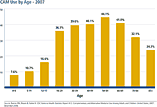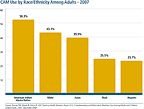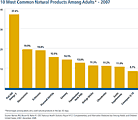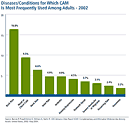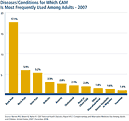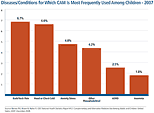The Use of Complementary and Alternative Medicine in the United States
On this page:
- About CAM
- How Many People Use CAM
- Who Uses CAM Most
- CAM Therapies Used the Most
- CAM Therapies Included in the 2007 NHIS
- Use of Natural Products
- Health Conditions Prompting CAM Use
- CAM Use Among Children
- Additional Reports
- Footnote
- For More Information
In December 2008, the National Center for Complementary and Alternative Medicine (NCCAM) and the National Center for Health Statistics (part of the Centers for Disease Control and Prevention) released new findings on Americans' use of complementary and alternative medicine (CAM). The findings are from the 2007 National Health Interview Survey (NHIS), an annual in-person survey of Americans regarding their health- and illness-related experiences. The CAM section gathered information on 23,393 adults aged 18 years or older and 9,417 children aged 17 years and under. A similar CAM section was included in the 2002 NHIS, providing the opportunity to examine trends in CAM use, too.1
About CAM
CAM is a group of diverse medical and health care systems, practices, and products that are not generally considered part of conventional medicineMedicine as practiced by holders of M.D. (medical doctor) or D.O. (Doctor of Osteopathic Medicine) degrees and by their allied health professionals such as physical therapists, psychologists, and registered nurses.. Complementary medicine is used together with conventional medicine, and alternative medicine is used in place of conventional medicine. Integrative medicine combines conventional and CAM treatments for which there is evidence of safety and effectiveness. While scientific evidence exists regarding some CAM therapies, for most there are key questions that are yet to be answered through well-designed scientific studies—questions such as whether these therapies are safe and whether they work for the purposes for which they are used. NCCAM's mission is to explore CAM practices using rigorous scientific methods and build an evidence base for the safety and effectiveness of these practices.
How Many People Use CAM
In the United States, approximately 38 percent of adults (about 4 in 10) and approximately 12 percent of children (about 1 in 9) are using some form of CAM, shown in figure 1.
Who Uses CAM Most
People of all backgrounds use CAM. However, CAM use among adults is greater among women and those with higher levels of education and higher incomes. Figure 2 shows the percentage of people using CAM by age. Figure 3 shows CAM use by race/ethnicity.
CAM Therapies Used the Most
Nonvitamin, nonmineral natural products are the most commonly used CAM therapy among adults. Use has increased for several therapies, including deep breathing exercises, meditationA conscious mental process using certain techniques—such as focusing attention or maintaining a specific posture—to suspend the stream of thoughts and relax the body and mind., massagePressing, rubbing, and moving muscles and other soft tissues of the body, primarily by using the hands and fingers. The aim is to increase the flow of blood and oxygen to the massaged area. therapy, and yoga. Figure 4 shows the percentage of people using the most common CAM therapies and therapies with significant increases between 2002 and 2007.
CAM Therapies Included in the 2007 NHIS
- Acupuncture*
- Ayurveda*
- Biofeedback*
- Chelation therapy*
- Chiropractic or osteopathic manipulation*
- Deep breathing exercises
- Diet-based therapies
- Atkins diet
- Macrobiotic diet
- Ornish diet
- Pritikin diet
- South Beach diet
- Vegetarian diet
- Zone diet
- Energy healing therapy/Reiki*
- Guided imagery
- Homeopathic treatment
- Hypnosis*
- Massage*
- Meditation
- Movement therapies
- Alexander technique
- Feldenkrais
- Pilates
- Trager psychophysical integration
- Natural products (nonvitamin and nonmineral, such as herbs and other products from plants, enzymes, etc.)
- Naturopathy*
- Progressive relaxation
- Qi gong
- Tai chi
- Traditional healers*
- Botanica
- Curandero
- Espiritista
- Hierbero or Yerbera
- Native American healer/Medicine man
- Shaman
- Sobador
- Yoga
An asterisk (*) indicates a practitioner-based therapy. For definitions of any of these therapies, see the full report (PDF) or contact the NCCAM Clearinghouse.
Use of Natural Products
The most popular natural products are fish oil/omega 3, glucosamineA substance found in the fluid around joints and used by the body to make and repair cartilage. Glucosamine in dietary supplements is made in the laboratory or from the shells of shrimp, lobster, and crabs., echinacea, and flaxseed. Figure 5 ranks the top 10 natural products used among adults in 2007 and 2002 (note that the 2007 survey asked about use in the last 30 days, whereas the 2002 survey asked about use in the last year).
Health Conditions Prompting CAM Use
People use CAM for an array of diseases and conditions. American adults are most likely to use CAM for musculoskeletal problems such as back, neck, or joint pain. The use of CAM therapies for head or chest colds showed a substantial decrease from 2002 to 2007. Figure 6 ranks the top 10 conditions prompting CAM use among adults for 2007 and 2002.
CAM Use Among Children
The 2007 NHIS asked selected adult respondents about CAM use by children in their households. Overall, approximately 12 percent of children use some form of CAM. Use is greater among:
- Children whose parents used CAM (23.9%)
- Adolescents aged 12-17 (16.4%), compared to younger children
- White children (12.8%), compared to Hispanic children (7.9%) and black children (5.9%)
- Children whose parents had higher education levels (more than high school: 14.7%)
- Children with six or more health conditions (23.8%)
- Children whose families delayed conventional care because of cost (16.9%)
Figures 7–9 show survey findings on CAM use by children, including top therapies, natural products, and diseases/conditions.
Additional Reports
NCCAM plans to collaborate with NCHS on further analyses of the survey findings. Among the areas of interest to the researchers are CAM costs and spending, dietary supplements, and reasons for CAM use. Future reports will be published by NCHS and posted on the NCCAM web site.
Footnote
- Unless noted otherwise, the statistics are for CAM use during the 12 months prior to the 2007 survey. Comparisons from the 2002 NHIS are indicated.
About NCCAM
NCCAM's mission is to explore complementary and alternative healing practices in the context of rigorous science, train CAM researchers, and disseminate authoritative information to the public and professionals.
To Obtain the Report
The report's citation is Barnes PM, Bloom B, Nahin R. CDC National Health Statistics Report #12. Complementary and Alternative Medicine Use Among Adults and Children: United States, 2007. December 2008. It is available, along with a press release and graphics, at nccam.nih.gov/news/camstats/. People who do not have access to the Internet can contact the NCCAM Clearinghouse for a copy.
For More Information
NCCAM Clearinghouse
The NCCAM Clearinghouse provides information on NCCAM and complementary health approaches, including publications and searches of Federal databases of scientific and medical literature. The Clearinghouse does not provide medical advice, treatment recommendations, or referrals to practitioners.
This publication is not copyrighted and is in the public domain. Duplication is encouraged.
* Note: PDF files require a viewer such as the free Adobe Reader.


